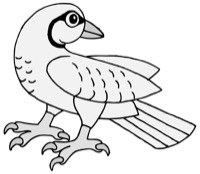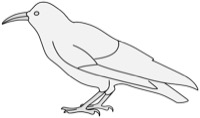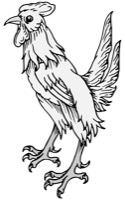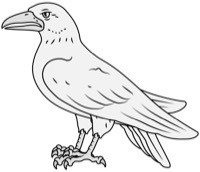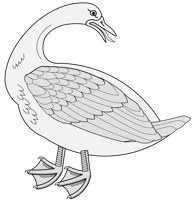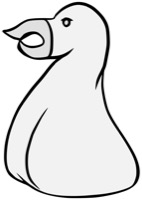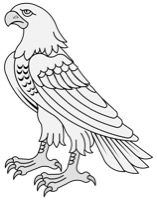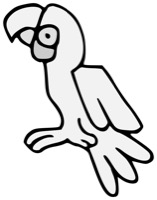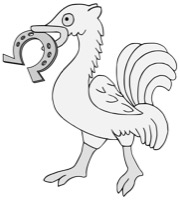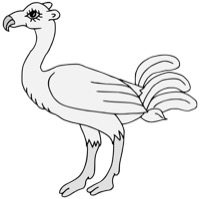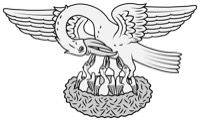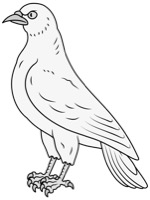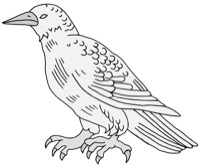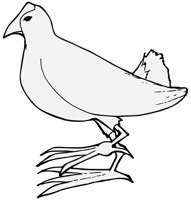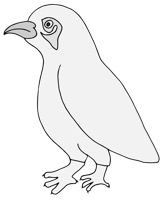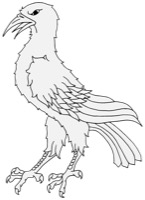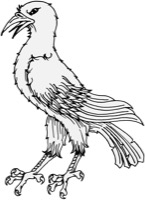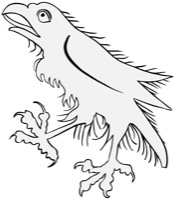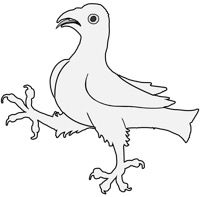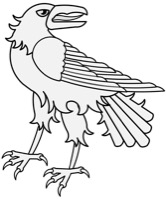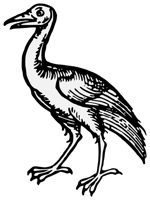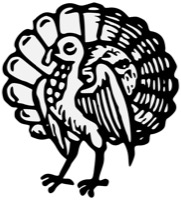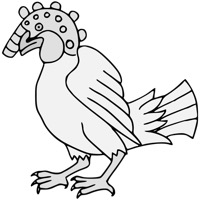126 Entries • Display: Details | Items
Great Auk §
A flightless seabird of the North Atlantic. Despite their resemblance to penguins, they are not closely related.
Hunted to extinction in the nineteenth century.
Default posture: close. Proper coloration: sable with argent belly.
Source: Viking Answer Lady SVG Images For Heralds. Artist: Gunnvôr silfrahárr.
Bird (1) §
A generic avian.
Default posture: close. No proper coloration.
Source: Viking Answer Lady SVG Images For Heralds. Artist: Gunnvôr silfrahárr.
Bird (2) §
A generic avian.
Default posture: close. No proper coloration.
Source: Kenmon Shokamon. Artist unknown. (Page 27.)
Bird (3) §
A generic avian.
Default posture: close. No proper coloration.
Source: Pennsic 50 Art Tent. Artist: Flori de Josselin. Adapted from a design by Gunnvôr silfrahárr.
Bird Regardant §
A generic avian.
Default posture: close. No proper coloration.
Source: Pennsic 50 Art Tent. Artist: Flori de Josselin. Adapted from a design by Gunnvôr silfrahárr.
Chough §
A cliff-dwelling cousin of the crow, often associated with Cornish heraldry.
Default posture: close. Proper coloration: black with red beak and legs.
Artist: Tali Essen of the Isles.
Cock (1) §
A male chicken, known in modern English as a rooster.
Default posture: close. No proper coloration.
Source: Pennsic Traceable Art. Artist: Roana d’Evreux (attributed).
Cock (2) §
A male chicken, known in modern English as a rooster.
Default posture: close. No proper coloration.
Source: Viking Answer Lady SVG Images For Heralds. Artist: Gunnvôr silfrahárr.
Cock (3) §
A male chicken, known in modern English as a rooster.
Default posture: close. No proper coloration.
Source: Banners, Standards, and Badges. Artist: Thomas Willement.
Cock (4) §
A male chicken, known in modern English as a rooster.
Default posture: close. No proper coloration.
Source: Pennsic Traceable Art Archives. Artist: Gunnvôr silfrahárr.
Cock (5) §
A male chicken, known in modern English as a rooster.
Default posture: close. No proper coloration.
Source: Two Tudor Books of Arms. Artist: Robert Cooke.
Cock (6) §
A male chicken, known in modern English as a rooster.
Default posture: close. No proper coloration.
Source: Wikimedia Commons. Artist: Syryatsu. License: Released into the public domain.
Cock (7) §
A male chicken, known in modern English as a rooster.
Default posture: close. No proper coloration.
Artist: Saewynn aet Cnolle. Adapted from Insignia Urbium Italiae Septentrionalis. (Arms of "De Caponis," folio 108r.)
Cock (8) §
A male chicken, known in modern English as a rooster.
Default posture: close. No proper coloration.
Source: Viking Answer Lady SVG Images For Heralds. Artist: Gunnvôr silfrahárr.
Cock (9) §
A male chicken, known in modern English as a rooster.
Default posture: close. No proper coloration.
Source: Heraldic Templates. Artist: Torric inn Björn.
Double-Headed Cock (1) §
A male chicken, known in modern English as a rooster.
Default posture: close. No proper coloration.
Source: Viking Answer Lady SVG Images For Heralds. Artist: Gunnvôr silfrahárr.
Double-Headed Cock (2) §
A male chicken, known in modern English as a rooster.
Default posture: close. No proper coloration.
Source: Zurich Roll. Artist unknown. Adapted by Vémundr Syvursson.
Crow (1) §
A corvid, like the raven.
Default posture: close. Proper coloration: sable.
Source: Heraldic Templates. Artist: Torric inn Björn.
Crow (2) §
A corvid, like the raven.
Default posture: close. Proper coloration: sable.
Source: SVG Heraldry Components. Artist: Nicholas de Estleche. Adapted by Mathghamhain Ua Ruadháin.
Crow (3) §
A corvid, like the raven.
Default posture: close. Proper coloration: sable.
Source: Banners, Standards, and Badges. Artist: Thomas Willement.
Crow (4) §
A corvid, like the raven.
Default posture: close. Proper coloration: sable.
Source: Wappenbuch der Arlberg-Bruderschaft. Artist: Vigil Raber. (Folio 21r.) Adapted by Kattera Doplerin.
Crow (5) §
A corvid, like the raven.
Default posture: close. Proper coloration: sable.
Source: Stemmario Trivulziano. Artist: Gian Antonio da Tradate. (Page 99, arms of di Corbis.)
Crow (6) §
A corvid, like the raven.
Default posture: close. Proper coloration: sable.
Source: WappenWiki. Artist: Joakim Spuller. Adapted by Mathghamhain Ua Ruadháin.
Crow Regardant §
A corvid, like the raven.
Default posture: close. Proper coloration: sable.
Source: WappenWiki. Artist: Joakim Spuller.
Dove (1) §
A peaceful bird with a tuft on the top of its head.
Default posture: close. Proper coloration: argent, with gules (or pink) feet and beak.
Source: Viking Answer Lady SVG Images For Heralds. Artist: Gunnvôr silfrahárr.
Dove (2) §
A peaceful bird with a tuft on the top of its head.
Default posture: close. Proper coloration: argent, with gules (or pink) feet and beak.
Source: Le Blason Des Armoiries. Artist: Jérôme de Bara. (Page 139.)
Dove Migrant to Base §
A peaceful bird with a tuft on the top of its head.
Default posture: close. Proper coloration: argent, with gules (or pink) feet and beak.
Source: Österreichisches Wappenbuch. Artist unknown.
Falcon (1) §
A bird of prey. May also be blazoned a “hawk.”
Default posture: close. Proper coloration: brown.
Source: Pennsic Bored-Artist Collection. Artist: Stephanie Fahey.
Falcon (2) §
A bird of prey. May also be blazoned a “hawk.”
Default posture: close. Proper coloration: brown.
Source: Workes of Armorie. Artist: John Bossewell.
Falcon Regardant §
A bird of prey. May also be blazoned a “hawk.”
Default posture: close. Proper coloration: brown.
Source: Pennsic Traceable Art. Artist: Roana d’Evreux (attributed).
Falcon Belled §
A bird of prey. May also be blazoned a “hawk.”
Default posture: close. Proper coloration: brown.
The term “belled” indicates that there are small hawk's bells tied to its legs.
Source: Two Tudor Books of Arms. Artist: Robert Cooke.
Falcon Jessed (1) §
A bird of prey. May also be blazoned a “hawk.”
Default posture: close. Proper coloration: brown.
The term “jessed” indicates that there are thongs tied around its legs
Source: Pennsic Traceable Art. Artist: Roana d’Evreux (attributed).
Falcon Jessed (2) §
A bird of prey. May also be blazoned a “hawk.”
Default posture: close. Proper coloration: brown.
The term “jessed” indicates that there are thongs tied around its legs.
Source: Heraldic Templates. Artist: Torric inn Björn.
Falcon Hooded and Jessed §
A bird of prey. May also be blazoned a “hawk.”
Default posture: close. Proper coloration: brown.
The term “jessed” indicates that there are thongs tied around its legs.
Source: Heraldic Templates. Artist: Torric inn Björn.
Falcon Hooded Belled and Jessed Seated Upon A Glove §
A bird of prey. May also be blazoned a “hawk.”
Default posture: close. Proper coloration: brown.
Source: Pennsic Traceable Art. Artist: Roana d’Evreux (attributed).
Flamingo One Leg Raised §
A long-legged shoreline bird, found around the coast of the Mediterranean as well as in the Caribbean, Africa, and South Asia.
Default posture: close. Proper coloration: pink or red.
Source: Pennsic Traceable Art. Artist unknown.
Goose §
A waterfowl.
Default posture: close. No proper coloration.
Source: Viking Answer Lady SVG Images For Heralds. Artist: Gunnvôr silfrahárr.
Goose Regardant §
A waterfowl.
Default posture: close. No proper coloration.
Source: Viking Answer Lady SVG Images For Heralds. Artist: Gunnvôr silfrahárr. Adapted by Vémundr Syvursson.
Demi-Goose §
A waterfowl.
Default posture: close. No proper coloration.
Source: Familienwappen des Hohen Adels. Artist unknown. (Folio 9v.) Adapted by Elionora inghean Ui Cheallaigh.
Hawk (1) §
A bird of prey.
Default posture: close. No proper coloration.
Source: The Art of Heraldry. Artist unknown.
Hawk (2) §
A bird of prey. Heraldically equivalent to a falcon.
Default posture: close. No proper coloration.
Source: Pennsic Traceable Art. Artist unknown.
Hawk (3) §
A bird of prey. Heraldically equivalent to a falcon.
Default posture: close. No proper coloration.
Artist: Gunnvôr silfrahárr.
Hawk Guardant §
A bird of prey. Heraldically equivalent to a falcon.
Default posture: close. No proper coloration.
Source: Pennsic Traceable Art. Artist unknown.
Hen (2) §
A female chicken.
Default posture: close. No proper coloration.
Source: Pennsic Traceable Art Archives. Artist: Gunnvôr silfrahárr.
Hen (3) §
Hummingbird Hovering §
A swift and agile bird.
Default posture: close. No proper coloration.
The posture “hovering” is used for hummingbirds with wings elevated and addorsed, head forward, and tail beneath the body.
Source: Viking Answer Lady SVG Images For Heralds. Artist: Gunnvôr silfrahárr. Adapted by Mathghamhain Ua Ruadháin.
Macaw §
A colorful New-World cousin of the parrot.
Default posture: close. No proper coloration.
Source: Codex Fejérváry-Mayer. Artist unknown. Adapted by Máel Brigte.
Magpie §
A clever and talkative member of the crow family.
Default posture: close. Proper coloration: sable, with argent belly and wing tips.
Source: Worksop Bestiary. (Morgan Library MS M.81. Folio 53r.) Artist unknown. Adapted by Máel Brigte.
Martlet (1) §
A stylized bird, perhaps originally related to the swallow, now defined by its lack of legs, as myth suggests it never lands.
Default posture: Close. No proper coloration.
Source: Viking Answer Lady SVG Images For Heralds. Artist: Gunnvôr silfrahárr.
Martlet (2) §
A stylized bird, perhaps originally related to the swallow, now defined by its lack of legs, as myth suggests it never lands.
Default posture: Close. No proper coloration.
This depiction is no longer registrable following the February 2018 finding that period martlets were not drawn with split swallow-tails.
Source: A Complete Guide to Heraldry. Artist: Graham Johnston.
Martlet (3) §
A stylized bird, perhaps originally related to the swallow, now defined by its lack of legs, as myth suggests it never lands.
Default posture: Close. No proper coloration.
This depiction is no longer registrable following the February 2018 finding that period martlets were not drawn with split swallow-tails.
Source: Pennsic Traceable Art. Artist: Roana d’Evreux (attributed). Adapted by Mathghamhain Ua Ruadháin.
Martlet (4) §
A stylized bird, perhaps originally related to the swallow, now defined by its lack of legs, as myth suggests it never lands.
Default posture: Close. No proper coloration.
Source: Guillim’s Display of Heraldry. Artist unknown.
Martlet (5) §
A stylized bird, perhaps originally related to the swallow, now defined by its lack of legs, as myth suggests it never lands.
Default posture: Close. No proper coloration.
This depiction is no longer registrable following the February 2018 finding that period martlets were not drawn with split swallow-tails.
Source: Fictitious & Symbolic Creatures in Art. Artist: John Vinycomb.
Martlet (6) §
A stylized bird, perhaps originally related to the swallow, now defined by its lack of legs, as myth suggests it never lands.
Default posture: Close. No proper coloration.
Source: Two Tudor Books of Arms. Artist: Robert Cooke. (From page 151, arms of Watyr Walcotte.)
Martlet (7) §
A stylized bird, perhaps originally related to the swallow, now defined by its lack of legs, as myth suggests it never lands.
Default posture: Close. No proper coloration.
This depiction is no longer registrable following the February 2018 finding that period martlets were not drawn with split swallow-tails.
Source: Pennsic Heralds’ Point Artists. Artist unknown.
Martlet (8) §
A stylized bird, perhaps originally related to the swallow, now defined by its lack of legs, as myth suggests it never lands.
Default posture: Close. No proper coloration.
Source: Pennsic Heralds’ Point Artists. Artist unknown. Adapted by Mathghamhain Ua Ruadháin.
Merlette §
A bird found in French armory, related to the English martlet, but lacking both legs and beak.
Default posture: close. No proper coloration.
Source: Le Blason Des Armoiries. Artist: Jérôme de Bara. (Page 184.)
Moorcock §
A male grouse, a type of wild poultry prized by hunters.
Default posture: close. Proper coloration: black with white markings.
Source: SVG Heraldry Components. Artist: Nicholas de Estleche.
Ostrich (1) §
A large flightless bird found in Africa.
Default posture: close. No proper coloration.
Source: A Complete Guide to Heraldry. Artist: Graham Johnston.
Ostrich (2) §
A large flightless bird found in Africa.
Default posture: close. No proper coloration.
Source: The Tudor Pattern Book. Artist unknown. Adapted by Owen Tegg.
Ostrich (3) §
A large flightless bird found in Africa.
Default posture: close. No proper coloration.
Source: Funeral Arms and Commissions for Visitations. Artist unknown. (Folio 132r.)
Ostrich (4) §
A large flightless bird found in Africa.
Default posture: close. No proper coloration.
Source: St. Gallen Armorial. Artist: Unknown. Adapted by Máel Brigte.
Ostrich (5) §
A large flightless bird found in Africa.
Default posture: close. No proper coloration.
Often depicted eating a metal item such as a horseshoe or key.
Source: St. Gallen Armorial. Artist: Unknown. Adapted by Máel Brigte.
Ostrich (6) §
A large flightless bird found in Africa.
Default posture: close. No proper coloration.
Source: Aja'ib al-Makhluqat wa Ghara'ib al-Mawjudat. (Leiden MS Or. 8907.) Artist: Zakariya al-Qazwini. Adapted by Máel Brigte.
Ostrich Feather §
A large flightless bird found in Africa.
Default posture: close. No proper coloration.
Artist: Wylet Fraser.
Peacock (1) §
A large bird known for its showy tail.
Default posture: close. Proper coloration: blue and green.
Source: Pennsic Traceable Art. Artist unknown.
Peacock (2) §
A large bird known for its showy tail.
Default posture: close. Proper coloration: blue and green.
Source: Pennsic Traceable Art. Artist unknown.
Peacock (3) §
A large bird known for its showy tail.
Default posture: close. Proper coloration: blue and green.
Source: Viking Answer Lady SVG Images For Heralds. Artist: Gunnvôr silfrahárr. Adapted by Mathghamhain Ua Ruadháin.
Peacock (4) §
A large bird known for its showy tail.
Default posture: close. Proper coloration: blue and green.
Source: BnF MS Français 412. Artist: Richard de Fournival. (Folio 232v.)
Peacock One Leg Raised §
A large bird known for its showy tail.
Default posture: close. Proper coloration: blue and green.
Source: Viking Answer Lady SVG Images For Heralds. Artist: Gunnvôr silfrahárr.
Peacock In His Pride (1) §
A large bird known for its showy tail.
Default posture: close. Proper coloration: blue and green.
The phrase “in his pride” means that the tail is displayed behind him.
Source: Pennsic Traceable Art. Artist unknown.
Peacock In His Pride (2) §
A large bird known for its showy tail.
Default posture: close. Proper coloration: blue and green.
The phrase “in his pride” means that the tail is displayed behind him.
Source: Viking Answer Lady SVG Images For Heralds. Artist: Gunnvôr silfrahárr.
Peacock In His Pride (3) §
A large bird known for its showy tail.
Default posture: close. Proper coloration: blue and green.
The phrase “in his pride” means that the tail is displayed behind him.
Source: Roman mosaic. Artist unknown. (“The Peacock Mosaic,” middle of second century CE, Musée Theo Desplan, Vaison-la-Romaine, France.) Adapted by Forveleth Dunde.
Pelican In Its Piety (1) §
A fish-eating sea bird. In myth, it would pierce it’s own breast to save the lives of its offspring.
Default posture: close. Reserved for members of the Order of the Pelican.
Source: Heraldic Templates. Artist: Torric inn Björn. Adapted by Þórý Veðardóttir.
Pelican In Its Piety (2) §
A fish-eating sea bird. In myth, it would pierce it’s own breast to save the lives of its offspring.
Default posture: close. No proper coloration.
Reserved for members of the Order of the Pelican.
Source: Fictitious & Symbolic Creatures in Art. Artist: John Vinycomb.
Pelican In Its Piety (3) §
A fish-eating sea bird. In myth, it would pierce it’s own breast to save the lives of its offspring.
Reserved for members of the Order of the Pelican.
Default posture: close. No proper coloration.
Source: Viking Answer Lady SVG Images For Heralds. Artist: Gunnvôr silfrahárr.
Pelican In Its Piety (4) §
A fish-eating sea bird. In myth, it would pierce it’s own breast to save the lives of its offspring.
Default posture: close. No proper coloration.
Reserved for members of the Order of the Pelican.
Source: Ortus Sanitatis. Artist unknown.
Pelican In Its Piety (5) §
A fish-eating sea bird. In myth, it would pierce it’s own breast to save the lives of its offspring.
Default posture: close. No proper coloration.
Reserved for members of the Order of the Pelican.
Source: Harley MS 709. Artist unknown. (Folio 22r.)
Pelican In Its Piety (6) §
A fish-eating sea bird. In myth, it would pierce it’s own breast to save the lives of its offspring.
Default posture: close. No proper coloration.
Reserved for members of the Order of the Pelican.
Source: Sledgehamster. Artist: Grimwulf Harland. Adapted from an illustration by Dürer.
Pelican In Its Piety (7) §
A fish-eating sea bird. In myth, it would pierce it’s own breast to save the lives of its offspring.
Default posture: close. No proper coloration.
Reserved for members of the Order of the Pelican.
Artist: Albrecht Drurer. Adapted by Jessimond of Emerickeskepe.
Pelican In Its Piety (8) §
A fish-eating sea bird. In myth, it would pierce it’s own breast to save the lives of its offspring.
Default posture: close. No proper coloration.
Reserved for members of the Order of the Pelican.
Source: A fifteenth-century Itallian repoussé copper plaquette. Artist unknown. Adapted by Malyss Makneile.
Pelican In Its Piety (9) §
A fish-eating sea bird. In myth, it would pierce it’s own breast to save the lives of its offspring.
Default posture: close. No proper coloration.
Reserved for members of the Order of the Pelican.
Source: Österreichische Chronik des Konrad Grünenberg. (Page 122.) Artist unknown. Adapted by Malyss Makneile.
Pelican In Its Piety (10) §
A fish-eating sea bird. In myth, it would pierce it’s own breast to save the lives of its offspring.
Default posture: close. No proper coloration.
Reserved for members of the Order of the Pelican.
Source: Stammbuch Hans Ludwig Pfinzing von Henfenfeld. (Folio 40v.) Artist unknown. Adapted by Malyss Makneile.
Pelican In Its Piety (11) §
A fish-eating sea bird. In myth, it would pierce it’s own breast to save the lives of its offspring.
Default posture: close. No proper coloration.
Reserved for members of the Order of the Pelican.
Source: Met Museum. (Accession 64.101.1498.) Artist unknown. Adapted by Malyss Makneile.
Pelican In Its Piety (12) §
A fish-eating sea bird. In myth, it would pierce it’s own breast to save the lives of its offspring.
Default posture: close. No proper coloration.
Reserved for members of the Order of the Pelican.
Source: Victoria and Albert Museum. (Accession 1792-1855.) Artist unknown. Adapted by Malyss Makneile.
Pelican In Its Piety (13) §
A fish-eating sea bird. In myth, it would pierce it’s own breast to save the lives of its offspring.
Default posture: close. No proper coloration.
Reserved for members of the Order of the Pelican.
Source: WappenWiki. Artist: Joakim Spuller.
Pelican Vulning Itself (1) §
A fish-eating sea bird. In myth, it would pierce it’s own breast to save the lives of its offspring.
Default posture: close. Reserved for members of the Order of the Pelican.
Source: Heraldic Templates. Artist: Torric inn Björn. Adapted by Þórý Veðardóttir.
Pelican Vulning Itself (2) §
A fish-eating sea bird. In myth, it would pierce it’s own breast to save the lives of its offspring.
Reserved for members of the Order of the Pelican.
Default posture: close. No proper coloration.
Source: Viking Answer Lady SVG Images For Heralds. Artist: Gunnvôr silfrahárr. Adapted by Mathghamhain Ua Ruadháin.
Pelican Vulning Itself (3) §
A fish-eating sea bird. In myth, it would pierce it’s own breast to save the lives of its offspring.
Default posture: close. No proper coloration.
Reserved for members of the Order of the Pelican.
Source: Two Tudor Books of Arms. Artist: Robert Cooke. (From page 150, arms of John Pellam.)
Pelican Vulning Itself (4) §
A fish-eating sea bird. In myth, it would pierce it’s own breast to save the lives of its offspring.
Default posture: close. No proper coloration.
Reserved for members of the Order of the Pelican.
Artist: Albrecht Drurer. Adapted by Jessimond of Emerickeskepe.
Pelican Vulning Itself (5) §
A fish-eating sea bird. In myth, it would pierce it’s own breast to save the lives of its offspring.
Default posture: close. No proper coloration.
Reserved for members of the Order of the Pelican.
Source: Wappenbuch Fol 223. (Folio 55v.) Artist unknown. Adapted by Malyss Makneile.
Pelican Vulning Itself (6) §
A fish-eating sea bird. In myth, it would pierce it’s own breast to save the lives of its offspring.
Default posture: close. No proper coloration.
Reserved for members of the Order of the Pelican.
Source: Met Museum. (Accession 64.101.1498.) Artist unknown. Adapted by Malyss Makneile.
Natural Pelican §
A fish-eating sea bird. In myth, it would pierce it’s own breast to save the lives of its offspring.
Default posture: close. No proper coloration.
Reserved for members of the Order of the Pelican.
Source: Fictitious & Symbolic Creatures in Art. Artist: John Vinycomb.
Pigeon (1) §
A peaceful bird closely related to the dove, but lacking a tuft on the top of its head.
Default posture: close. No proper coloration.
Source: WappenWiki. Artist: Joakim Spuller.
Pigeon (2) §
A peaceful bird closely related to the dove, but lacking a tuft on the top of its head.
Default posture: close. No proper coloration.
Source: Le Blason Des Armoiries. Artist: Jérôme de Bara. (Page 95.) Adapted by Máel Brigte.
Poppinjay (1) §
A clever bird that may learn to speak. Sometimes blazoned a “parrot.”
Default posture: close. Frequently shown with one foot raised to step forward, as if passant.
Proper coloration: green with red beak and details.
Source: Pennsic Traceable Art. Artist: Roana d’Evreux (attributed).
Poppinjay (2) §
A clever bird that may learn to speak. Sometimes blazoned a “parrot.”
Default posture: close. Frequently shown with one foot raised to step forward, as if passant.
Proper coloration: green with red beak and details.
Source: A Complete Guide to Heraldry. Artist: Graham Johnston.
Poppinjay (3) §
A clever bird that may learn to speak. Sometimes blazoned a “parrot.”
Default posture: close. Frequently shown with one foot raised to step forward, as if passant.
Proper coloration: green with red beak and details.
Source: Le Blason Des Armoiries. Artist: Jérôme de Bara. (Page 94.)
Poppinjay (4) §
A clever bird that may learn to speak. Sometimes blazoned a “parrot.”
Default posture: close. Frequently shown with one foot raised to step forward, as if passant.
Proper coloration: green with red beak and details.
Source: WappenWiki. Artist: Joakim Spuller.
Porphyrio §
A swamphen, found around the Mediteranean and throughout the tropics, with colorful plumage and prominant feet and face shield.
Default posture: close. No proper coloration, with varieties occurring in numerous shades of purple, green, blue, and gray.
Artist: Vémundr Syvursson.
Puffin §
Sea-diving birds of the northern ocean.
Default posture: close. Proper coloration: belly argent, wings sable, beak and legs Or.
Source: Pennsic Heralds’ Point Artists. Artist unknown.
Quail §
A small bird in the poultry family.
Default posture: close. No proper coloration.
Source: Codex Mendoza. (Folio 15v.) Artist unknown. Adapted by Máel Brigte.
Raven (1) §
A corvid, like the crow, but typically drawn with “rough” or “hairy” feathers.
Default posture: close. Proper coloration: sable.
Source: Pennsic Traceable Art. Artist unknown.
Raven (2) §
A corvid, like the crow, but typically drawn with “rough” or “hairy” feathers.
Default posture: close. Proper coloration: sable.
Source: Pennsic Traceable Art. Artist unknown.
Raven (3) §
A corvid, like the crow, but typically drawn with “rough” or “hairy” feathers.
Default posture: close. Proper coloration: sable.
Source: Heraldic Templates. Artist: Torric inn Björn. Adapted by Þórý Veðardóttir.
Raven (4) §
A corvid, like the crow, but typically drawn with “rough” or “hairy” feathers.
Default posture: close. Proper coloration: sable.
Source: Heraldic Templates. Artist: Torric inn Björn.
Raven (5) §
A corvid, like the crow, but typically drawn with “rough” or “hairy” feathers.
Default posture: close. Proper coloration: sable.
Source: Viking Answer Lady SVG Images For Heralds. Artist: Gunnvôr silfrahárr.
Raven (6) §
A corvid, like the crow, but typically drawn with “rough” or “hairy” feathers.
Default posture: close. Proper coloration: sable.
Artist: Jessimond of Emerickeskepe.
Raven (7) §
A corvid, like the crow, but typically drawn with “rough” or “hairy” feathers.
Default posture: close. Proper coloration: sable.
Artist: Jessimond of Emerickeskepe.
Raven (8) §
A corvid, like the crow, but typically drawn with “rough” or “hairy” feathers.
Default posture: close. Proper coloration: sable.
Artist: Li Xia.
Raven One Leg Raised (1) §
A corvid, like the crow, but typically drawn with “rough” or “hairy” feathers.
Default posture: close. Proper coloration: sable.
Source: Wappenbuch Conrads von Grünenberg. Artist unknown. Adapted by Graham Johnston and Saewynn aet Cnolle.
Raven One Leg Raised (2) §
A corvid, like the crow, but typically drawn with “rough” or “hairy” feathers.
Default posture: close. Proper coloration: sable.
Source: Scheibler Armorial. Artist: Unknown. (Page 119.)
Raven Regardant §
A corvid, like the crow, but typically drawn with “rough” or “hairy” feathers.
Default posture: close. Proper coloration: sable.
Source: Viking Answer Lady SVG Images For Heralds. Artist: Gunnvôr silfrahárr.
Robin §
Simurgh Close §
An imposing bird of Persian myth, related to the Russian firebird.
No default posture. No proper coloration.
As a non-European animal, considered a step from core practice (SFCP).
Source: Pennsic Traceable Art. Artist unknown.
Stork §
A large, long-legged, long-necked shore bird.
Default posture: close. No proper coloration.
Source: Guillim’s Display of Heraldry. Artist unknown.
Stork Maintaining in its Beak a Snake §
A large, long-legged, long-necked shore bird.
Default posture: close. No proper coloration.
Source: A Complete Guide to Heraldry. Artist: Graham Johnston.
Swan Close (1) §
A fierce waterfowl, resembling an unusually large and long-necked duck.
Default posture: rousant. No proper coloration.
Artist: Jon Chesey. Adapted from Anton Tirol's Wappenbuch (German, c. 1540).
Swan Close (2) §
A fierce waterfowl, resembling an unusually large and long-necked duck.
Default posture: rousant. No proper coloration.
Artist: Iago ab Adam. Adapted from Wappenbuch Conrads von Grünenberg.
Swan Close (3) §
A fierce waterfowl, resembling an unusually large and long-necked duck.
Default posture: rousant. No proper coloration.
Artist: Kitta Refr.
Swan Close (4) §
A fierce waterfowl, resembling an unusually large and long-necked duck.
Default posture: rousant. No proper coloration.
Source: WappenWiki. Artist: Joakim Spuller.
Titmouse (1) §
A small songbird of North America.
Default posture: close. No proper coloration.
Artist: Ræv Kolfinnsson.
Turkeycock (1) §
A large bird of the Americas. Introduced to Europe in the 16th century.
Default posture: close. Often shown with tail displayed. No proper coloration.
Source: Guillim’s Display of Heraldry. Artist unknown.
Turkeycock (2) §
A large bird of the Americas. Introduced to Europe in the 16th century.
Default posture: close. Often shown with tail displayed. No proper coloration.
Source: Codex Mendoza. (Folio 16r.) Artist unknown. Adapted by Máel Brigte.
Wood Cock In His Pride §
A ground-living bird of the forest. Also known as the “wood grouse” or “heather cock.” Males display a ruff of tail feathers as part of courting.
Default posture: close. No proper coloration.
Source: OpenClipArt. Artist: Paxed.





